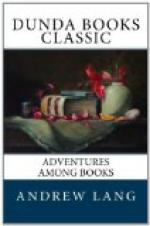“Though lame, he was nimble, and all rough and alive with power; had you met him anywhere else, you would say he was a Liddesdale store farmer, come of gentle blood—’a stout, blunt carle,’ as he says of himself, with the swing and stride and the eye of a man of the hills—a large, sunny, out-of-door air all about him. On his broad and stooping shoulders was set that head which, with Shakespeare’s and Bonaparte’s, is the best known in all the world.” Scott was then living in 39 Castle Street. I do not know whether the many pilgrims, whom one meets moving constantly in the direction of Melrose and Abbotsford, have thought of making pilgrimage to Castle Street, and to the grave, there, of Scott’s “dear old friend,”—his dog Camp. Of Dr. Brown’s schoolboy days, one knows little—days when “Bob Ainslie and I were coming up Infirmary Street from the High School, our heads together, and our arms intertwisted, as only lovers and boys know how or why.” Concerning the doctor’s character, he has left it on record that he liked a dog-fight. “‘A dog-fight,’ shouted Bob, and was off, and so was I, both of us all hot, praying that it might not be over before we were up . . . Dogs like fighting; old Isaac (Watts, not Walton) says they ‘delight’ in it, and for the best of all reasons; and boys are not cruel because they like to see the fight. This is a very different thing from a love of making dogs fight.” And this was the most famous of all dog-fights—since the old Irish Brehons settled the laws of that sport, and gravely decided what was to be done if a child interfered, or an idiot, or a woman, or a one-eyed man—for this was the dog-fight in which Rab first was introduced to his historian.
Six years passed after this battle, and Dr. Brown was a medical student and a clerk at Minto Hospital. How he renewed his acquaintance there, and in what sad circumstances, with Rab and his friends, it is superfluous to tell, for every one who reads at all has read that story, and most readers not without tears. As a medical student in Edinburgh, Dr. Brown made the friendship of Mr. Syme, the famous surgeon—a friendship only closed by death. I only saw them once together, a very long time ago, and then from the point of view of a patient. These occasions are not agreeable, and patients, like the old cock which did not crow when plucked, are apt to be “very much absorbed”; but Dr. Brown’s attitude toward the man whom he regarded with the reverence of a disciple, as well as with the affection of a friend, was very remarkable.




